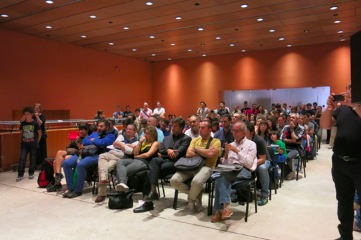A few weeks before Getting Started with Adafruit Trinket went to press, Adafruit introduces the Pro Trinket. It hits a sweet spot in terms of price, performance, and size between the Trinket and the Arduino Uno. In my comparison chart in the book it was a bit late to add the Pro Trinket so I'll do it here. First, sizing them up visually:
 |
| Adafruit Trinket (top), Pro Trinket (middle) and Arduino Uno (bottom) (source: Adafruit) |
The Pro Trinket is closer to Trinket's size than an Arduino Uno. It's smaller than an Arduino Micro or Nano I believe but not by a lot.
Adafruit Trinket
|
Adafruit Pro Trinket
|
Arduino Uno
|
|
Processor
|
ATtiny85
Surface Mount |
ATmega328P QFN package
|
ATmega328P
DIP Package |
Digital Pins
|
5
|
12
|
14
|
Analog Pins
|
3 (shared)
|
8
|
6
|
Pulse Width Modulated Pins
|
3
|
6
|
6
|
Pin Voltage
|
3.3 or 5 volts
|
3.3 or 5 volts
|
5 Volts
|
Board Voltage
|
3.3 or 5 volts
|
3.3 or 5 volts
|
5 Volts (3.3 on a pin)
|
Regulated Current Out
|
150ma
|
150ma
|
800ma
|
Power via 3.7V LiPo
|
Possible
|
Possible
|
No
|
USB Chip Onboard
|
No
|
No (but has FTDI header)
|
Yes
|
USB Plug Type
|
Mini-USB
|
Micro-USB
|
USB-B
|
USB Programmable
|
Yes
|
Yes
|
Yes
|
Memory (RAM/EEPROM)
|
512 / 512 bytes
|
2048 / 1024 bytes
|
2048 / 1024 bytes
|
Flash Memory (free)
|
8K (5,130 free)
|
32K (28,672 bytes free)
|
32K (32K free)
|
Add-on Shields
|
No
|
No
|
Yes
|
Board Size
|
31mm x 15.5 x 5mm
|
38mm x 18mm x 2mm
|
75.14 x 53.51 x 15.08mm
|
Approximate Cost
|
$6.95
|
$9.95
|
$24.95
|
In terms of Pro Trinket compatibility with Uno, the Pro Trinket does not have digital pins 2 and 7 exposed to pins (they are permanently used for USB, although you could hack into the USB resistors with very fine wire to get them). Sketches that use pins 2 and 7 may most likely be modifiable to use other pins.
Like some Uno clones, the Pro Trinket adds analog pins 6 and 7 which could be very useful in some applications.
What do you think? Does the Pro Trinket fit in well in the spectrum of available microcontrollers? Capability, price, size?









